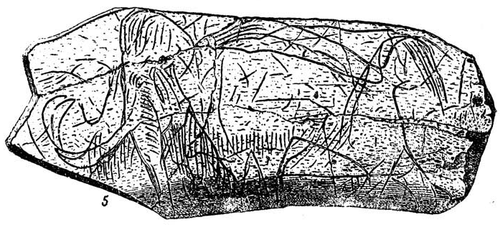Holly Oak Gorget: Difference between revisions
mNo edit summary |
mNo edit summary |
||
| Line 1: | Line 1: | ||
By Haley Allgeyer | By Haley Allgeyer | ||
The Holly Oak Gorget is a shell pendant, worn as a necklace, with a carving in it of what appears to by a woolly mammoth. This artifact was allegedly discovered in the late 1860’s, by Hilborne T. Cresson, a field assistant at the time at Harvard University’s Peabody Museum. The pendant was found at an archaeological site in northern Delaware [1]. The shell is made of busycon sinistrum, a sea snail, often found along the United States coast of the Atlantic Ocean. | |||
The Holly Oak Gorget is a shell pendant, worn as a necklace, with a carving in it of what appears to by a woolly mammoth. This artifact was allegedly discovered in the late 1860’s, by Hilborne T. Cresson, a field assistant at the time at Harvard University’s Peabody Museum. The pendant was found at an archaeological site in northern Delaware. The shell is made of busycon sinistrum, a sea snail, often found along the United States coast of the Atlantic Ocean. | |||
[[File:Holly_oak_gorget.jpg|400px|thumb|caption]] | [[File:Holly_oak_gorget.jpg|400px|thumb|caption]] | ||
==History== | ==History== | ||
===Gorgets=== | |||
A gorget or pendant is a sort of decorative necklace worn to display a person’s status. In Native American culture, it is common for a gorget to be carved out of materials such as shells, mollusks, gourds, etc. [3]. Different gorgets commonly show a person’s status within their tribe. Carvings can be related to family origins or tribe symbols. Because gorgets hold such great information about the tribe or owner who wore it, they are important archaeological finds. They can tell us many things about who wore the gorget, where it was carved, and the ancient community around the owner. In the example of the Holly Oak Gorget, if it were not fabricated, we could assume that the owner who wore the gorget encountered woolly mammoths, as that is what is carved into it. | |||
===Discovery=== | |||
Announced in 1889. | |||
===La Madeleine=== | ===La Madeleine=== | ||
Edouard Lartet discovered La Madeleine pendant | In 1864, Edouard Lartet discovered La Madeleine pendant which depicts a woolly mammoth carving, very similar to the Holly Oak carving [2]. Though, Hilborne T. Cresson claims he discovered the Holly Oak Gorget prior to public discovery of La Madeleine, Cresson did not speak of his finding until after La Madeleine made the news. After La Madeleine was discovered, both the pendant, and Lartet received lots of attention. Because of the vast amount of attention that Lartet’s discovery received, reputable archaeologists have reason to believe that Cresson was after the similar fame and fortune [2]. | ||
[[File:mammoth_carved_on_ivory.png|500px|thumb|caption]] | |||
===Harvard University's Peabody Museum=== | ===Harvard University's Peabody Museum=== | ||
Hilborne T. Cresson | During the time of both La Madeleine discovery and the Holly Oak Gorget discovery, Hilborne T. Cresson worked as a field assistant at Harvard University’s Peabody Museum of Archaeology and Ethnology[1]. | ||
[ | |||
Revision as of 21:59, 4 December 2019
By Haley Allgeyer
The Holly Oak Gorget is a shell pendant, worn as a necklace, with a carving in it of what appears to by a woolly mammoth. This artifact was allegedly discovered in the late 1860’s, by Hilborne T. Cresson, a field assistant at the time at Harvard University’s Peabody Museum. The pendant was found at an archaeological site in northern Delaware [1]. The shell is made of busycon sinistrum, a sea snail, often found along the United States coast of the Atlantic Ocean.

History
Gorgets
A gorget or pendant is a sort of decorative necklace worn to display a person’s status. In Native American culture, it is common for a gorget to be carved out of materials such as shells, mollusks, gourds, etc. [3]. Different gorgets commonly show a person’s status within their tribe. Carvings can be related to family origins or tribe symbols. Because gorgets hold such great information about the tribe or owner who wore it, they are important archaeological finds. They can tell us many things about who wore the gorget, where it was carved, and the ancient community around the owner. In the example of the Holly Oak Gorget, if it were not fabricated, we could assume that the owner who wore the gorget encountered woolly mammoths, as that is what is carved into it.
Discovery
Announced in 1889.
La Madeleine
In 1864, Edouard Lartet discovered La Madeleine pendant which depicts a woolly mammoth carving, very similar to the Holly Oak carving [2]. Though, Hilborne T. Cresson claims he discovered the Holly Oak Gorget prior to public discovery of La Madeleine, Cresson did not speak of his finding until after La Madeleine made the news. After La Madeleine was discovered, both the pendant, and Lartet received lots of attention. Because of the vast amount of attention that Lartet’s discovery received, reputable archaeologists have reason to believe that Cresson was after the similar fame and fortune [2].

Harvard University's Peabody Museum
During the time of both La Madeleine discovery and the Holly Oak Gorget discovery, Hilborne T. Cresson worked as a field assistant at Harvard University’s Peabody Museum of Archaeology and Ethnology[1].
Pseudoarchaeological Claims
Hilborne T. Cresson
Forgotten Controversy
John Kraft and Ronald Thomas
Modern Understandings
Fake
References
Griffin, James B., Meltzer, David J., Smith, Bruce D., Sturtevant, William C.
1988 A Mammoth Fraud in Science. American Antiquity, 53(3), 578-582. doi:10.2307/281218
Jochim, Michael A.
1985 American Anthropologist, 87(1), new series, 158-160.